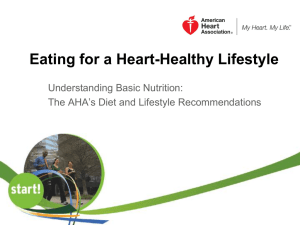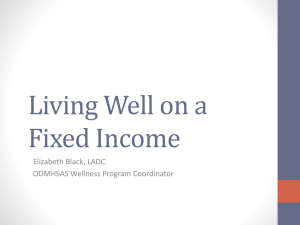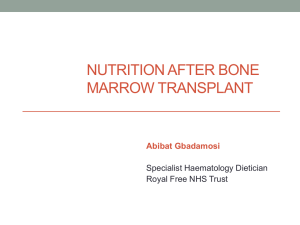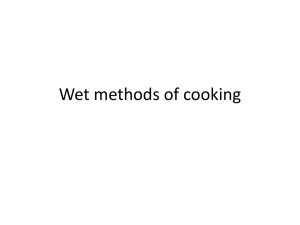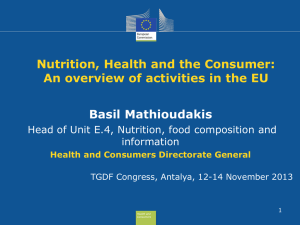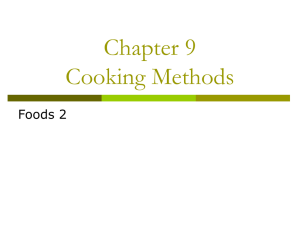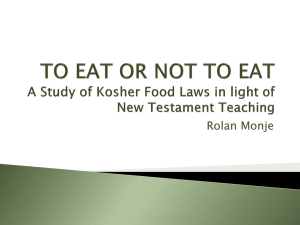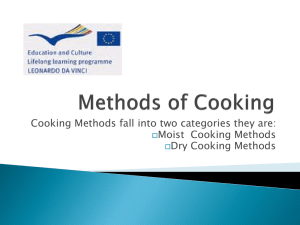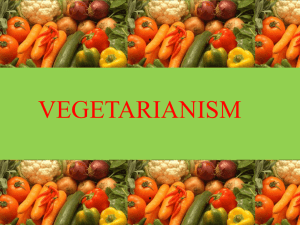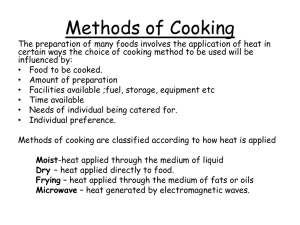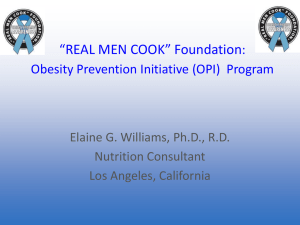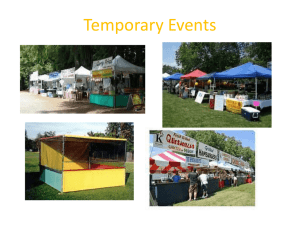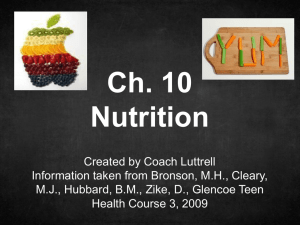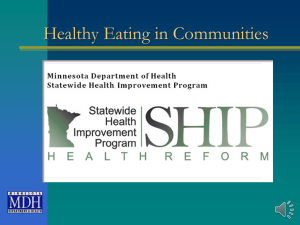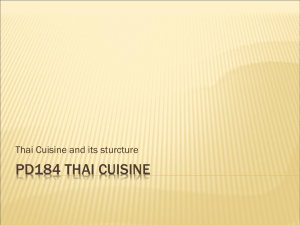Food & culture
advertisement
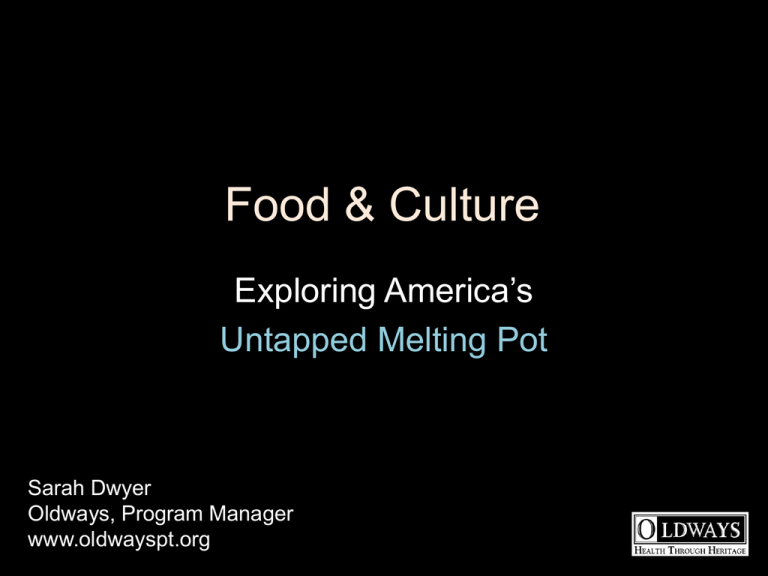
Food & Culture Exploring America’s Untapped Melting Pot Sarah Dwyer Oldways, Program Manager www.oldwayspt.org Our Melting Pot’s Food Culture Today A. Dang it! B. We are the bomb.com! • • • • • Facebook Sharing • Foodie Movement (Southie) • Farm To Table and Activist Chefs • 2% spent on fruit, veg, grain, and bean ads! • Documentarians (A+) • Community Gardens • Culinary Tourism • Vegans, Raw Foodists, Paleolithians, Breathatarians • • • • Standard American Diet = F Greasier and Faster “Don’t even tell me!” 90% of Saturday morning TV ad time goes to foods high in fat & sugar and low in essential nutrients Spending Billions on Nutrition Education Cooking = spectator sport We’re addicted But … we work out! How do we keep raising B. in our American food culture? One way: Through Cultural Roots “Food has no ethnicity … … only geography.” -- Musa Dagdeviren, Owner Ciya Sofrasi New York Times Review For those who don't have a Turkish grandfather to cook traditional dishes, there's Musa Dagdeviren, the Turkish-Kurdish proprietor of this restaurant. A culinary Indiana Jones, he gathers gustatory secrets from remote provinces and serves a menu that may include ezo gelin (lentil soup with oregano and red pepper), diyarbakir guvec (a savory stew of lamb, tomatoes and soft eggplants) and kuru sebze domalsi (eggplant stuffed with rice and lamb). He is also a Midas of fruits, transforming them into golden juices (tamarind, anyone?) and desserts like candied pumpkin slices. The menu is in Turkish, so take a Turkish friend or make one at the restaurant. Food Shapes Us A Brief Geography Lesson North Foods: root vegetables, crisp apples, Swedish meatballs People: grounded, sharp folks driving more Volvos per capita South Foods: tropical fruits, yerba mate, superfoods and spices People: sunny, energetic types who like to salsa Geography Natural Resources Culture Individual Eating patters = Individual + Collective Food Choices Early on: Food = Survival No matter what the ancient food economy was, individuals found it hard to live without a group – sharing ingredients, cooking pots, and fires, and simply hoping to receive enough from the pot to survive Tribes and Clans Empires and Regions Nations and Ethnicities Tribes & Clans Nations & Ethnicity • Localized identity rooted in immediately available resources • Connection & association based on language, region, resources, kinship and food • The birth of movements for independence and nationlism • “Ethnic Cuisine” Foodstuffs Movin’ and Shakin’ : The Dawn of Food Universality Crops :: Livestock :: Spices :: People :: Cuisine Cuisine The Rules of … – Cooking: what ingredients, how they should be combined, what processes to apply – Eating: who should eat what, when, and with whom – Rules of food service (how dishes should be served and in what order) – “Cuisine” deemed different from everyday cooking, in a hierarchical sense Cuisine & Culture Early Foundations Class Structures: What does Affluence Taste Like? – From Survival to Decadence – Landowners vs. Working Class The Banquet Years: A Gorge-ous time! – Access to Exotic foods – Foods in Excess: Animal Fats, Breads, Sweets, Wine “Bourgeois meals reached such proportions that an intermission had to be introduced in the form of a sherbet course between the two fowl dishes.” •Affluent Health? •Gout, Diabetes, Obesity Modern American Food Culture Colonization and Food-Marriages in America – – – – – – England, Netherlands, France and Spain Spanish: Florida, New Mexico, California, Texas French: Louisiana, Illinois country Dutch in New York British in New England Quakers of Pennsylvania What does food mean socially to these groups? What will be the lineage? A couple of outcomes: Decadence Jackson Heart Study - Fried animal fats, soda, white bread, high sodium foods Coca-cola: The Simple Things A symbol of All-American, love for the good life, but economical, a result of a hardworking democracy that knows that they want, but doesn’t want too much Why Pseudo Foods? • • • • • Industrial Evolutions Acculturation – back to survival Pop Culture and Gov. Subsidies Women to the workforce Nuclear families grow to adopt separate activities that keep lives busy & eating solo • Modern Conveniences: remote controls, elevators, car washes, leaf blowers • Loss of cooking promotion & passing-downs in families America’s Techno-Food Movement Chemicalized, Genetically Modified, Homogenized, Subsidized, Tranquilized A Man & His Curiosity: Is There A Better Way? Gardening & Nutrition + Fishing + Capitol Hill + Julia Child + Earth Day + A little bit of travel expedition ____________________ Recipe for K. Dun Gifford’s Oldways Vision What kind of food culture do we intend to leave our children? How can a population that may double by the middle of this century be fed in sustainable ways? K. Dun Gifford, Oldways Founder How can consumers who want healthier food and a cleaner environment get the chance to vote with their forks? New Values, Perspectives & Dolce Vita Qufu, China 1987 A Tour of Italy Geographic Patterns of Disease And Traditional Diets • Rockefeller Study in Crete, Greece post WWII • Ansel Keys, Seven Countries Study • T. Colin Campbell and The Cornell-ChinaOxford Project, which would become known as The China Study • Denis Burkitt, of Burkitt’s Lymphoma and Dietary Fiber in Africa • Harvard School of Public Health Global Engergy Consumption, WHO, 2008 Global Meat Consumption, 2008 Prevalence of Obesity, WHO, 2008 As Red Meat Intake Rises in Japan, So Does Colon Cancer Incidence As Asian populations have changed from traditional to Westernizes diets, their consumption of red meat has increased. While this meat consumption is still considered moderate compared to Western standards, the Japanese are still experiencing the negative effects associated with red meat consumption; particularly colon or rectal cancer. A 2011 Japanese study administered a food frequency questionare to 80,658 men and women aged 45 to 74 years during 1995-1998. Higher consumption of red meat was significantly associated with a higher risk of colon cancer among men and women. In terms of site, these significant associations were found to be proximal colon cancer in women and distal colon cancer in men. National Cancer Center, Tokyo Japan Obesity in Nigeria: Current Trends and Management Nigeria is facing an increasing prevalence of obesity, with a particularly strong occurrence in populations with hypertension and diabetes. A Nigerian study of these increases says that the rise of obesity rates can easily be attributed to rapid unplanned urbanization, change from local dietary pattern to western style diet which is driven by the proliferation of fast food outlets in major cities across the country. This study makes that connection. Nigerian Medical Practitioner Vol. 54 No 1, 2008 (11-5). Akpa et al. Nutrition-Shifts Oldways’ Five Traditional Pyramids Oldways 1. Whole Grains Council and Stamp Program (2003) 2. Latino Nutrition Collection (2005) 3. Mediterranean Food Alliance (2006) 4. CME Conferences for Physicians and Healthcare Professionals 5. Oldways Nutrition Exchange for Supermarket Dietitians 6. Culinary Travel “I have yet to hear of a traditional diet — from any culture, anywhere in the world — that is not substantially healthier than the ‘standard American diet.’ The more we honor cultural differences in eating, the healthier we will be.” Michael Pollan The New York Times Magazine Sunday, October 2, 2011 Regional Health & Longevity Places Where 90 Is The New 30 • Okinawa, Japan • Sardinia, Italy • Nicoya Peninsula, Costa Rica • Seventh Day Adventists (Vegetarian) in Loma Linda, California *4 Out of 5 of Oldways Pyramids: Asia, Mediterranean, Latin America, and Vegetarian Food Reflections: New Priorities Standard American Diet • Value on speed, no fuss, MRE’s (Made Ready To Eat) • Chemicalized, Genetically Modified, De-Naturized, Food Products • Meat at the center of the plate • Factory-farm dependent • Billions Spent on Nutrition Education Traditional + Cultural Eating • Reclaim cooking as an intricate part of life and society • Real food and drinks • Plant-based, traditional diets of healthy populations • “Meet” your food at a garden or farm • Play with spices and flavors from around the world • More enjoyment & paying attention New Perspectives Sometimes it is necessary to reteach a thing its loveliness. -- Galway Kinnel Passive Eaters • Eating as “Consumers” • Buying what we want – or what we have been persuaded to want • Pay, mostly without protest, what we are charged Active Eaters • Eating as Co-Creators • Eating as an agricultural act – We are actively involved in the drama of food economy, from planting seeds to fork piercing – No longer just consumers The ideal of a single civilization for everyone, implicit in the cult of progress and technique, impoverishes and mutilates us. Every view of the world that becomes extinct, every culture that disappears, diminishes a possibility of life. -- Octavio Paz Crocuses To Help Us Focus … es Sustainable Food Choices: Health, Environment, and Cultural Traditions If each of us gets curious about our own food traditions, or sharpen our focus on others that pique our interests and taste buds, think of all we might bring to a new, elevated & delicious food culture in America. Let the old ways be your guide to good health and wellbeing!
